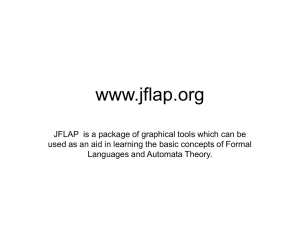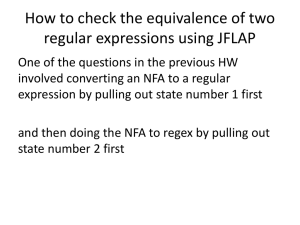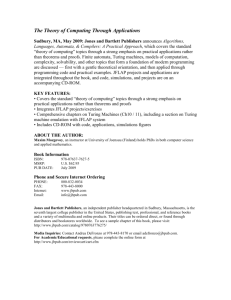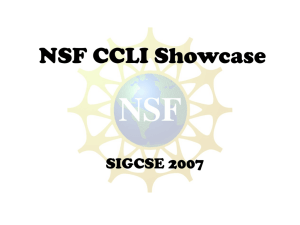talkHaverfordApr10
advertisement
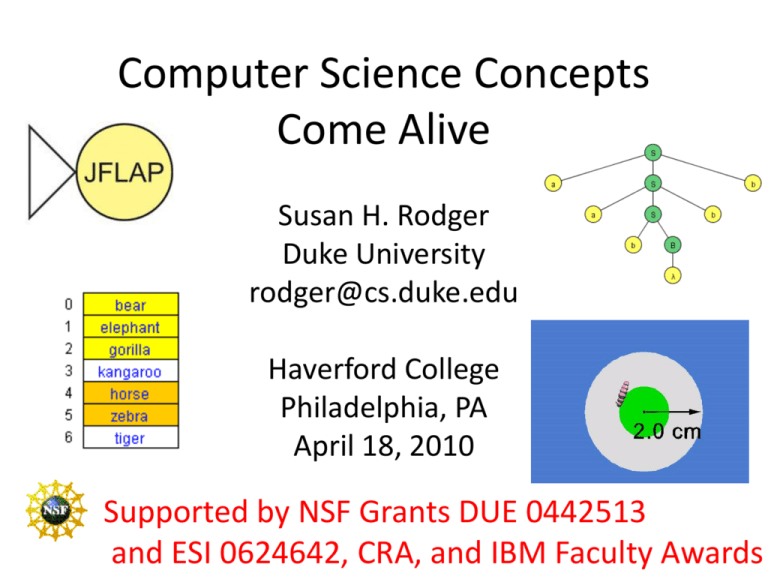
Computer Science Concepts
Come Alive
Susan H. Rodger
Duke University
rodger@cs.duke.edu
Haverford College
Philadelphia, PA
April 18, 2010
Supported by NSF Grants DUE 0442513
and ESI 0624642, CRA, and IBM Faculty Awards
Outline
• Introduction
• CS Concepts Come Alive with Software
– CS 1/CS 2 with JAWAA
– Automata Theory with JFLAP
– Pre-CS 1 with Alice
• CS Concepts Come Alive with Props
• Challenges in Designing Educational Software
• Integrating Computer Science into K-12
About Me - Research Interests
• Computer Science Education
• Visualization and Interaction
– Instructional Tools for Theoretical concepts
• Automata theory and formal languages
– Teaching Introductory Computer Science
• Algorithm Animation
A bit about me, my background…
PhD, 1989
Computer Science
Assistant Prof.
1989-1994
Professor of the Practice
1994-present
About Me - Personally
Spouse
Mother
About Me - These keep me busy…
About Me - Hobby – Baking Shape cakes
How do you make those cakes?
Why find interactive and visual
approaches to learning?
Students Ready to learn
Automata Theory!
Things start well enough …
But soon, instead of pictures,
there are WORDS.
Big words! The type with
more than one syllable!
VIOLENCE AMONG
STUDENTS AS NERVES FRAY!
We only wanted to learn automata
theory! Isn’t there a better way?
Try JFLAP …
Students Learning Automata
with JFLAP
Intro - Why Use Interaction and
Visualization?
• Learning Styles
– Visual Learners
• Learn through seeing
• Learn best from visual displays
– Auditory Learners
• Learn through listening
• Learn best through verbal lectures, discussions
– Kinesthetic Learners
• Learn through moving, doing and touching
• Learn best through hands-on approach
How do you reach all three types?
• You must do all three!
– Provide pictures, diagrams
– Discuss what you are doing
– Provide activities for trying it
Outline
• Introduction
• CS Concepts Come Alive with Software
– CS 1/CS 2 with JAWAA
– Automata Theory with JFLAP
– Pre-CS 1 with Alice
• CS Concepts Come Alive with Props
• Challenges in Designing Educational Software
• Integrating Computer Science into K-12
JAWAA
Java and Web-based Algorithm Animation
•
•
•
•
Scripting Language for Animation
Easily create, modify and move objects
Runs over the web, no need to install
More Advanced Students
• Output JAWAA Command from Program
• Animate Data Structures Easily
• SIGCSE 2003 and SIGCSE 1998
• www.cs.duke.edu/~rodger/tools/
• Students: Pierson, Patel, Finley, Akingbade,
Jackson, Gibson, Gartland
Related Work
• Samba, Jsamba - Stasko (Georgia Tech)
• AnimalScript – Roessling (Darmstadt Univ
of Tech, SIGCSE 2001)
• JHAVE – Naps (U. Wisc. Oshkosh, SIGCSE
2000)
• Lots of animations and systems on the
web!
JAWAA Commands
circle cl 30 20 60 blue red
moveRelative c1 60 0
move right
moveRelative c1 0 50
move down
changeParam c1 bkgrd blue
JAWAA Primitives
circle
rectangle
line
oval
polygon
text
JAWAA Data Structures
Array
JAWAA Data Structures
• Stack
• Queue
JAWAA Data Structures
• Linked List
• Trees
Use of JAWAA in CS 1/2
• Instructor
– Use JAWAA Editor to make quick
animations for lecture
– Show web pages with JAWAA animations
in lecture
– Students replay animations later
• Student
– Create animation of data structure in an
existing program, add JAWAA commands
as output
Instructor Animations for CS 2 Lecture
•
•
•
•
•
•
How Pointers Work in Memory
Recursion
Shellsort
Linked List - Insert at the Front
Quadratic Collision Resolution
Build Heap and Heapsort
Outline
• Introduction
• CS Concepts Come Alive with Software
– CS 1/CS 2 with JAWAA
– Automata Theory with JFLAP
– Pre-CS 1 with Alice
• CS Concepts Come Alive with Props
• Challenges in Designing Educational Software
• Integrating Computer Science into K-12
Formal Languages and Automata
Theory
• Traditionally taught
– Pencil and paper exercises
– No immediate feedback
– More mathematical than most CS courses
– Less hands-on than most CS courses
What is a finite automaton?
• Models a problem – represent a set of strings
• Example:
– All valid integers {-3, 8, 0, 456, 13, …}
– Starting place
• Start state
– Ending place
• Final state
DFA for all valid integers
DFA annotated and w/shortcut
Why study finite automata?
• Application: Compiler
• Compiler identifies your syntax errors
• Can write a big DFA to identify all words in a
Java program
– integers, doubles, boolean
– keywords, variable names
– arithmetic operators, punctuation symbols
Why Develop Tools for Automata?
Textual
Tabular
Visual
Interactive
Overview of JFLAP
• Java Formal Languages and Automata
Package
• Instructional tool to learn concepts of
Formal Languages and Automata Theory
• Topics:
– Regular Languages
– Context-Free Languages
– Recursively Enumerable Languages
– Lsystems
• With JFLAP your creations come to life!
Thanks to Students - Worked on JFLAP
and Automata Theory Tools
20 years!
• NPDA - 1990, C++, Dan Caugherty
• FLAP - 1991, C++, Mark LoSacco, Greg Badros
• JFLAP - 1996-1999, Java version
Eric Gramond, Ted Hung, Magda and Octavian Procopiuc
• Pâté, JeLLRap, Lsys
Anna Bilska, Jason Salemme, Lenore Ramm, Alex
Karweit, Robyn Geer
• JFLAP 4.0 – 2003, Thomas Finley, Ryan Cavalcante
• JFLAP 6.0 – 2005-2008 Stephen Reading, Bart Bressler,
Jinghui Lim, Chris Morgan, Jason Lee
• JFLAP 7.0 - 2009 Henry Qin, Jonathan Su
JFLAP - Regular Languages
• Create
– DFA and NFA
– Moore and Mealy
– regular grammar
– regular expression
• Conversions
– NFA to DFA to minimal DFA
– NFA regular expression
– NFA regular grammar
JFLAP – Regular languages (more)
• Simulate DFA and NFA
– Step with Closure or
Step by State
– Fast Run
– Multiple Run
•
•
•
•
Combine two DFA
Compare Equivalence
Brute Force Parser
Pumping Lemma
FA Edit & Simulation
Start up JFLAP
• When we start up
JFLAP we have a
choice of structures.
• The first of these is
the Finite Automata!
FA Edit & Simulation
Start Editing!
• We start with
an empty
automaton
editor window.
FA Edit & Simulation
Create States
• We create some
states ...
FA Edit & Simulation
Create Transitions
• We create some
transitions ...
FA Edit & Simulation
Initial and Final State
• We set an initial
and final state.
• Now we can
simulate input on
this automaton!
FA Edit & Simulation
Input to Simulate...
• When we say we
want to simulate
input on this
automaton, a
dialog asks us for
the input.
FA Edit & Simulation
Start Simulation!
• When simulation
starts, we have a
configuration on
the initial state
with all input
remaining to be
processed.
FA Edit & Simulation
After One Step
• This is a
nondeterministic
FA, and on this
input we have
multiple
configurations
after we “Step.”
FA Edit & Simulation
After Two Steps
• The previous
configurations on q1
and q2 are rejected,
and are shown in red.
• The remaining
uncolored
configurations paths
are not rejected, and
are still open.
FA Edit & Simulation
After Three Steps
• Yet another step.
FA Edit & Simulation
After Four Steps
• One of the final
configurations has
been accepted!
FA Edit & Simulation
Traceback
• One can then see a
traceback to see the
succession of
configurations that
led to the accepting
configuration.
FA Multiple Run
• Select Multiple
Run
• One can then
enter many
strings and
receive
acceptance info.
JFLAP – Context-free Languages
• Create
– Nondeterministic PDA
– Context-free grammar
– Pumping Lemma
• Transform
– PDA CFG
– CFG PDA (LL & SLR parser)
– CFG CNF
– CFG Parse table (LL and SLR)
– CFG Brute Force Parser
JFLAP – Recursively Enumerable
Languages
• Create
– Turing Machine (1-Tape)
– Turing Machine (multi-tape)
– Building Blocks
– Unrestricted grammar
• Parsing
– Unrestricted grammar with
brute force parser
L-Systems
• L-Systems may be used
to model biological
systems and create
fractals.
• Similar to Chomsky
grammars, except all
variables are replaced
in each derivation
step, not just one!
• Commonly, strings
from successive
derivations are
interpreted as strings
of render commands
and are displayed
graphically.
JFLAP - Lsystems
• Create an L-system
• Generate the strings
B
[T–B++B]
[Tg–[T–B++B]++[T–B++B]]
etc
• Render the L-system
JFLAP - L-Systems
• This L-System
renders as a tree that
grows larger with
each successive
derivation step.
L-Systems
• L-systems may also be
stochastic.
• The T→Tg rule adds g
to the derivation,
which draws a line
segment.
• We add another
rewriting rule for T,
T→T.
• With two rewriting
rules for T, the rule
chosen is random,
leading to uneven
growth!
L-Systems
The same stochastic L-system, rendered
3 different times all at the 9th derivation.
Students love L-Systems
Using JFLAP during Lecture
• Use JFLAP to build examples of automata or
grammars
• Use JFLAP to demo proofs
• Load a JFLAP example and students work in
pairs to determine what it does, or fix it if it is
not correct.
JFLAP’s use Outside of Class
• Homework problems
– Turn in JFLAP files
– OR turn in on paper, check answers in JFLAP
• Recreate examples from class
• Work additional problems
– Receive immediate feedback
JFLAP’s Use Around the World
• JFLAP web page has over 250,000 hits since 1996
• Google Search
– JFLAP appears on over 39,000 web pages
– Note: search only public web pages
• JFLAP now used in several textbooks – JFLAP exercises
• JFLAP been downloaded in over 160 countries
JFLAP in German
JFLAP in Spanish
JFLAP in Chinese
JFLAP Study
• Study of JFLAP’s effectiveness in learning
– Two year study
– Fourteen Faculty Adopters
– Two 2-day faculty Adopter Workshops – June
2005, June 2006
– Collect data 2005-06 and 2006-07 Academic years
– Pretest/Posttest
– Interviews
– Team of three evaluators
• Eric Weibe – Education
• Rocky Ross – Computer Science Theory
• Joe Bergin – Computer Science Tools
Fourteen
Faculty Adopter
Participants
-small, large
- public,
private
- includes
minority
institutions
•
•
•
•
•
•
•
•
•
•
•
•
•
•
Duke
UNC-Chapel Hill
Emory
Winston-Salem State University
United States Naval Academy
Rensselaer Polytechnic Institute
UC Davis
Virginia State University
Norfolk State University
University of Houston
Fayetteville State University
University of Richmond
San Jose State University
Rochester Institute of Technology
Conclusions From Study
• No Conclusive Results from Pretests/Postests
• Results of Study showed
– All the faculty used JFLAP in their courses, mostly for
homework, some in lecture
– Students had a high opinion of JFLAP
– Majority of students felt access to JFLAP
• Made learning course concepts easier
• Made them feel more engaged
• Made the course more enjoyable
– Over half the students used JFLAP to study for exams
– Over half the student thought time and effort using
JFLAP helped them get a better grade.
JFLAP is free
www.jflap.org
JFLAP tutorial
Outline
• Introduction
• CS Concepts Come Alive with Software
– CS 1/CS 2 with JAWAA
– Automata Theory with JFLAP
– Pre-CS 1 with Alice
• CS Concepts Come Alive with Props
• Challenges in Designing Educational Software
• Integrating Computer Science into K-12
Alice Programming Language
• Create interactive stories or games
• Learn programming in an easy way, dragand-drop your code
• Problem solving with visual feedback
– Objects are visual!
• Alice is free: www.alice.org
• Developed by Randy Pausch
Alice Programming Language
• Has libraries of 3D objects
• Keeps Track of objects you select
Objects Have Multiple Parts that are
moveable
• Objects
Object Position
– Are positioned in 3D space
– Have six degrees of freedom
Alice Code is Easy to Learn
Select Code, Drag-and-Drop code in program
Play Alice Animation
• Chicken rises, cow turns head and talks
Computer Science Concepts come
alive with Alice - Examples
•
•
•
•
Objects are visible
Variables
inheritance
Lists, Arrays
Variables –
Scores/Timers
Game: Eragon
4 tasks to win the game
Example - Inheritance
• Start with a chicken object
• Rename it to
TalentedChicken
– Change its color
– Resize it larger
– Add new methods (jump, fly,
scurry)
– Add events for this chicken
• Save this new class
TalentedChicken that inherits
from the Chicken class
Example - Arrays
• Shuffle, then sort by height
Example with ArrayVisualization
Swapping two elements in an array
• Swap the objects at positions 0 (fanDancer)
and 3 (duckPrince)
• Add in an ObjectVisualization, this is like a
variable for an object. (same folder where
ArrayVisualization is)
Swapping objects at 0 and 3 (cont)
• Only one element at a time can be in a slot
in the array. To swap two elements, you
have to move one of them out temporarily.
• Move object at index 0 to
objectVisualization (this frees up slot 0)
Swapping objects at 0 and 3 (cont)
• Now you can move the item in slot 3 over to
slot 0 (note the duckPrince moved over)
• Now slot 3 is empty
Swapping objects at 0 and 3 (cont)
• Now move the object that was originally in
slot 0 and was saved temporarily in the
ObjectVisualization, over to slot 3
Some projects from the Duke Alice
course…
Game:
Rumble Putt
Game: Sarah Palin’s Seaplane Adventure
Sarah Palin’s Seaplane Adventure (cont)
Game: Scarab Beetles take over
Game:
Candyland
Select girl and boy to play
Click on red and green buttons to
move them.
Game: Frogger – Get frog across road
Game: Dating Game
Outline
• Introduction
• CS Concepts Come Alive with Software
– CS 1/CS 2 with JAWAA
– Automata Theory with JFLAP
– Pre-CS 1 with Alice
• CS Concepts Come Alive with Props
• Challenges in Designing Educational Software
• Integrating Computer Science into K-12
Interaction in Class – Props
Passing “Parameters” in Class
• Pass by reference –
throw frisbee
• Pass by value – throw
copy of frisbee
• Pass by const
reference – throw
“protected” frisbee
Interaction in Class – Props
Linked List and Memory Heaps
ITiCSE 98 – Astrachan – “Concrete Teaching: Hooks and Props as
Instructional Technology
Interaction in Class – Props
Memory Heap
Example: Be a Robot
• 4 People
– Controller (head)
– Sensors (eyes)
– Manipulators (2 hands)
• Blindfolded except eyes
• Controller knows what
to build
• Limited communication
SIGCSE 96, Rodger,Walker
Interaction in Class – Props
Edible Turing Machine
• TM for f(x)=2x
where x is
unary
• TM is not
correct, can
you fix it? Then
eat it!
• States are
blueberry
muffins
Students building DFA with cookies
and icing
Outline
• Introduction
• CS Concepts Come Alive with Software
– CS 1/CS 2 with JAWAA
– Automata Theory with JFLAP
– Pre-CS 1 with Alice
• CS Concepts Come Alive with Props
• Challenges in Designing Educational Software
• Integrating Computer Science into K-12
Make your tool as interactive as
possible – but not too tedious!
• User shouldn’t type everything
• Sometimes select
Allow user to proceed on if they got it
• Complete
the rest
for them
• Complete
parts for
them
Avoid Too Many Pop up windows
• OLD JFLAP LR PARSE TOOL
Add Checkpoint questions
• Pop up a quiz question to see if the user
understands what he/she just did
• JHAVE tool does this
What can make the tool more
useable?
• Annotations on states
• Multiple run window
– Develop test data
– Easier for grading
• General definitions
– FA – recognize one or more symbols
– NPDA – pop or push 0 or more symbols
• Batch processing
Naming your software
What is a “good” name for your tool?
JAWAA name is not unique
How popular is
JAWAA?
JFLAP name is unique
Outline
• Introduction
• CS Concepts Come Alive with Software
– CS 1/CS 2 with JAWAA
– Automata Theory with JFLAP
– Pre-CS 1 with Alice
• CS Concepts Come Alive with Props
• Challenges in Designing Educational Software
• Integrating Computer Science into K-12
Engaging Middle School Teachers
and Students with Alice in a Diverse
Set of Subjects
Supported by the National Science Foundation Collaborative Grant
ESI-0624642, 0624654, 0624528, NSF Supplement DRL-0826661,
two CRA distributed mentor awards, and two Faculty Awards from
International Business Machines.
Problem – Few students major in CS
• Students come to college with their mind
made up on their career! This choice is based
on what they know.
• Students don’t know what computer science
is when in middle and high school
• They like Alice, but not staying with computer
science
Where could Alice help in decisions?
• Students in middle school are starting to form
decisions on careers
• They have exposure to Teachers, Doctors,
Astronauts, etc.
• They learn about Biology, Physics, Chemistry
– BUT DON’T KNOW WHAT COMPUTER SCIENCE IS
– THEIR EXPOSURE is SPREAD SHEETS,
POWERPOINT, etc.
Success - Alice Excites 4th-6th Grade
Girls
• Duke Femmes
Event, April 07
• 60 girls – 4
groups of 15
• Taught them
Alice for an hour
• Handout to take
home
• Event again in
2008 and 2009
Bring on Alice Virtual Worlds!
• Alice is
–
–
–
–
–
Hands-on!
Interactive!
Visual!
Less Error prone
Exciting Results right away!
• Alice has the potential to excite kids about
computer science in the same way that
experiments excite kids about chemistry, physics
and biology!
Adventures in Alice Programming
• Integrate Alice into high school and middle
schools by training teachers
• Six sites:
Durham, NC
Denver, CO
Charleston, SC
Oxford, MS
Virginia Beach, VA
San Jose, CA
• Durham site focuses on Middle Schools in NC
www.cs.duke.edu/csed/alice/aliceInSchools
Duke: Adventures in Alice site
• Summer 2008 and 2009
– 1-week and 3-week Teacher
workshops
• Over 130 teachers, mostly middle
school, some high school
• Only a few had ever programmed
before
• Taught them Alice, Developed
Lesson Plans
– 1-week middle school camps
• Taught Alice
• Lots of time to build their own
Alice worlds
Targetting all subject teachers
• Subject teachers using Alice
–
–
–
–
–
–
–
–
Language Arts
Mathematics
Science
History
Foreign Language
Music, Art
Media, Technology
Business
• Mostly Middle school, some Elementary, and some
high school subject teachers (physics, chemistry, etc)
How to Use Alice in Middle/High Schools
• Teachers
– Examples in lecture
– Make interactive quizzes
– Make worlds on concepts for students to view
• Students
– Projects (in place of a poster, a model)
– To take or build quizzes
– To view and answer questions about a world
– Older students can do more with Alice.
Examples of integrating Alice into K-12
Language Arts – book report
Science Example
How a volcano is formed
Math Example:
Teacher Lesson Plan on quadrant plane
• Click on
lighthouse
• Enter x,y
position
• Objects
randomly
move
Making Alice worlds
more real
- Use heads of familiar
people on 3D objects
Other Ideas for Projects
• Story from Ancient Egypt
• Spanish Quiz in which you see a
word and have to click on the
object the word represents
• Animate a scene from a book you
have read or a poem you have
written
• Create a world about school
safety
• Memory game – remember a
random color sequence
• Math Quiz – Answer the questions
Alice worlds for these and more are on our website.
Our Free Materials
Introductory Tutorials
1. Simple, Short (15 min) tutorials to try
Alice
–
Add an object, use built-in methods
2. One hour starting tutorials
–
Writing methods, simple events, camera
3. Four part tutorials if more time/more
detail
–
–
–
More detailed on placement of objects,
writing methods, events, camera control
Animating a skateboarder
Adding sound and images
Many short tutorials on
CS Topics
• CS Topics
– Programming – sequential and “at the same time”
– Methods (teaching characters how to walk)
– Events (buttons and birds)
– Looping
– Conditionals (making a choice)
– Functions (how tall are you)
– Lists (objects moving in unison)
– Variables (timers/scores)
Other “Fun” Topics Blended in
•
•
•
•
•
•
Storyboards
Changing camera views
Scene changes and lighting
Fading in/out
Making Billboards
Making objects invisible
and visible
• Sounds
• Glueing objects to others
Web site
• Adventures in Alice Programming
www.cs.duke.edu/csed/alice/aliceInSchools
Conclusion
• We have shown several ways to visualize CS
concepts and make them interactive
– Software: JAWAA, JFLAP, Alice
– Props: Food, frisbees, etc.
Questions?
